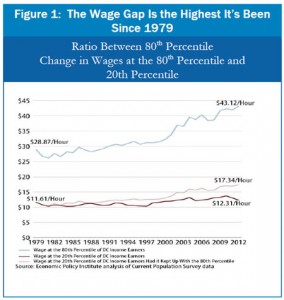Wage inequality in the District of Columbia is at its highest point in three decades, in part due to rapidly falling economic prospects for those without a college degree, according to a new DCFPI report released today. Residents with higher education have seen an increase in earnings and low unemployment while those without college degrees face declining wages and high unemployment even amid general prosperity in the city. The report also finds that the number of African-American DC residents with a job has dipped below 50 percent each year since 2009. And DC’s youngest workers have the highest unemployment rate of any age group.
Because residents without college degrees have limited access to jobs in DC’s high-education driven job market, investments and an increased focus on adult literacy,  sector-specific training, and youth work programs are needed. These changes would better prepare residents for the jobs the District has to offer, allowing them to also share in the city’s growing prosperity.
sector-specific training, and youth work programs are needed. These changes would better prepare residents for the jobs the District has to offer, allowing them to also share in the city’s growing prosperity.
Some major findings of the report include:
- The wage gap between high-wage and low-wage workers is the highest it’s been since 1979. The typical worker in the bottom 20 percent of wage earners saw their wages decrease from $13 an hour in 2008 to $12 an hour in 2012. Meanwhile, pay for high-wage workers rose $4 to an hourly rate of $43. This means high-wage workers earned nearly 3.5 times what a low-wage worker earned in 2012. The wage gap is 40 percent larger than in 1979.
- One-in-five residents without college degrees are unemployed, compared to 12 percent in 2008. In the meantime, wages for these residents dropped from $15 an hour to $12 an hour between 2008 and 2012, a $3 decrease in just four years.
- African-American and Hispanic adults have seen stagnant wages and high unemployment in the wake of the recession. Wages for Hispanic workers remained flat from 2008 to 2012 while wages for African-American workers increased just 2 percent. Unemployment rates for both African-American and Hispanic workers remain about two-thirds higher than at the start of the recession. By contrast, wages for white, non-Hispanic workers have increased by 9 percent and unemployment levels have fallen.
- Employment levels have fallen particularly for African-American adults. Under half of African-American adults in DC were employed in 2012, compared with 80 percent of white, non-Hispanic adults. Employment levels for African-American residents decreased at a much faster rate than employment for other racial or ethnic groups over the last four years, continuing a decades-long trend.
- Young workers face the highest unemployment levels of any age group. Unemployment for workers aged 16-24 grew from 13 percent in 2008 to 16 percent in 2012 ‘ double the unemployment rate of other age groups.
The District is a healthier city when all residents benefit from its prosperity. Mayor Gray and the DC Council have the chance with the fiscal year 2015 budget to make investments that can help ensure all residents can benefit from DC’s economic growth, by increasing funds for adult learning, youth employment, and focused, sector-specific job training. But money isn’t the only need. The District also needs to focus on accountability and better coordination of these programs to best serve residents.
To read the complete report, click here.
To print a copy of today’s blog, click here.
